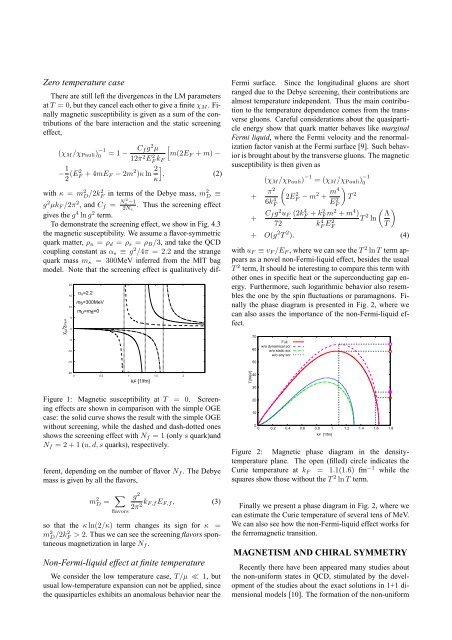Proceedings of International Conference on Physics in ... - KEK
Proceedings of International Conference on Physics in ... - KEK
Proceedings of International Conference on Physics in ... - KEK
You also want an ePaper? Increase the reach of your titles
YUMPU automatically turns print PDFs into web optimized ePapers that Google loves.
Zero temperature case<br />
There are still left the divergences <strong>in</strong> the LM parameters<br />
at T = 0, but they cancel each other to give a f<strong>in</strong>ite χM. F<strong>in</strong>ally<br />
magnetic susceptibility is given as a sum <str<strong>on</strong>g>of</str<strong>on</strong>g> the c<strong>on</strong>tributi<strong>on</strong>s<br />
<str<strong>on</strong>g>of</str<strong>on</strong>g> the bare <strong>in</strong>teracti<strong>on</strong> and the static screen<strong>in</strong>g<br />
effect,<br />
(χM/χPauli) −1<br />
0 = 1 − Cf g 2 µ<br />
12π 2 E 2 F kF<br />
− 1<br />
2 (E2 F + 4mEF − 2m 2 )κ ln 2<br />
κ<br />
[<br />
m(2EF + m) −<br />
]<br />
, (2)<br />
with κ = m2 D /2k2 F <strong>in</strong> terms <str<strong>on</strong>g>of</str<strong>on</strong>g> the Debye mass, m2D ≡<br />
g2 µkF /2π2 2<br />
Nc , and Cf = −1<br />
. Thus the screen<strong>in</strong>g effect<br />
2Nc<br />
gives the g4 ln g2 term.<br />
To dem<strong>on</strong>strate the screen<strong>in</strong>g effect, we show <strong>in</strong> Fig. 4.3<br />
the magnetic susceptibility. We assume a flavor-symmetric<br />
quark matter, ρu = ρd = ρs = ρB/3, and take the QCD<br />
coupl<strong>in</strong>g c<strong>on</strong>stant as αs ≡ g2 /4π = 2.2 and the strange<br />
quark mass ms = 300MeV <strong>in</strong>ferred from the MIT bag<br />
model. Note that the screen<strong>in</strong>g effect is qualitatively dif-<br />
χ M /χ Pauli<br />
20<br />
15<br />
10<br />
5<br />
0<br />
-5<br />
-10<br />
-15<br />
-20<br />
α S=2.2<br />
ms=300MeV<br />
mu=md=0<br />
0 0.5 1 1.5 2<br />
kF [1/fm]<br />
Figure 1: Magnetic susceptibility at T = 0. Screen<strong>in</strong>g<br />
effects are shown <strong>in</strong> comparis<strong>on</strong> with the simple OGE<br />
case: the solid curve shows the result with the simple OGE<br />
without screen<strong>in</strong>g, while the dashed and dash-dotted <strong>on</strong>es<br />
shows the screen<strong>in</strong>g effect with Nf = 1 (<strong>on</strong>ly s quark)and<br />
Nf = 2 + 1 (u, d, s quarks), respectively.<br />
ferent, depend<strong>in</strong>g <strong>on</strong> the number <str<strong>on</strong>g>of</str<strong>on</strong>g> flavor Nf . The Debye<br />
mass is given by all the flavors,<br />
m 2 D = ∑<br />
flavors<br />
g 2<br />
2π 2 kF,f EF,f , (3)<br />
so that the κ ln(2/κ) term changes its sign for κ =<br />
m2 D /2k2 F > 2. Thus we can see the screen<strong>in</strong>g flavors sp<strong>on</strong>taneous<br />
magnetizati<strong>on</strong> <strong>in</strong> large Nf .<br />
N<strong>on</strong>-Fermi-liquid effect at f<strong>in</strong>ite temperature<br />
We c<strong>on</strong>sider the low temperature case, T/µ ≪ 1, but<br />
usual low-temperature expansi<strong>on</strong> can not be applied, s<strong>in</strong>ce<br />
the quasiparticles exhibits an anomalous behavior near the<br />
Fermi surface. S<strong>in</strong>ce the l<strong>on</strong>gitud<strong>in</strong>al glu<strong>on</strong>s are short<br />
ranged due to the Debye screen<strong>in</strong>g, their c<strong>on</strong>tributi<strong>on</strong>s are<br />
almost temperature <strong>in</strong>dependent. Thus the ma<strong>in</strong> c<strong>on</strong>tributi<strong>on</strong><br />
to the temperature dependence comes from the transverse<br />
glu<strong>on</strong>s. Careful c<strong>on</strong>siderati<strong>on</strong>s about the quasiparticle<br />
energy show that quark matter behaves like marg<strong>in</strong>al<br />
Fermi liquid, where the Fermi velocity and the renormalizati<strong>on</strong><br />
factor vanish at the Fermi surface [9]. Such behavior<br />
is brought about by the transverse glu<strong>on</strong>s. The magnetic<br />
susceptibility is then given as<br />
(χM /χPauli) −1 = (χM /χPauli) −1<br />
0<br />
+ π2<br />
6k 4 F<br />
(<br />
2E 2 F − m 2 + m4<br />
E 2 F<br />
)<br />
T 2<br />
( )<br />
Λ<br />
T<br />
+ Cf g2uF (2k<br />
72<br />
4 F + k2 F m2 + m4 )<br />
k4 F E2 T<br />
F<br />
2 ln<br />
+ O(g 2 T 2 ). (4)<br />
with uF ≡ vF /EF , where we can see the T 2 ln T term appears<br />
as a novel n<strong>on</strong>-Fermi-liquid effect, besides the usual<br />
T 2 term, It should be <strong>in</strong>terest<strong>in</strong>g to compare this term with<br />
other <strong>on</strong>es <strong>in</strong> specific heat or the superc<strong>on</strong>duct<strong>in</strong>g gap energy.<br />
Furthermore, such logarithmic behavior also resembles<br />
the <strong>on</strong>e by the sp<strong>in</strong> fluctuati<strong>on</strong>s or paramagn<strong>on</strong>s. F<strong>in</strong>ally<br />
the phase diagram is presented <strong>in</strong> Fig. 2, where we<br />
can also asses the importance <str<strong>on</strong>g>of</str<strong>on</strong>g> the n<strong>on</strong>-Fermi-liquid effect.<br />
T [MeV]<br />
70<br />
60<br />
50<br />
40<br />
30<br />
20<br />
10<br />
Full.<br />
w/o dynamical scr.<br />
w/o static scr.<br />
w/o any scr.<br />
0<br />
0 0.2 0.4 0.6 0.8 1 1.2 1.4 1.6 1.8<br />
kF [1/fm]<br />
Figure 2: Magnetic phase diagram <strong>in</strong> the densitytemperature<br />
plane. The open (filled) circle <strong>in</strong>dicates the<br />
Curie temperature at kF = 1.1(1.6) fm −1 while the<br />
squares show those without the T 2 ln T term.<br />
F<strong>in</strong>ally we present a phase diagram <strong>in</strong> Fig. 2, where we<br />
can estimate the Curie temperature <str<strong>on</strong>g>of</str<strong>on</strong>g> several tens <str<strong>on</strong>g>of</str<strong>on</strong>g> MeV.<br />
We can also see how the n<strong>on</strong>-Fermi-liquid effect works for<br />
the ferromagnetic transiti<strong>on</strong>.<br />
MAGNETISM AND CHIRAL SYMMETRY<br />
Recently there have been appeared many studies about<br />
the n<strong>on</strong>-uniform states <strong>in</strong> QCD, stimulated by the development<br />
<str<strong>on</strong>g>of</str<strong>on</strong>g> the studies about the exact soluti<strong>on</strong>s <strong>in</strong> 1+1 dimensi<strong>on</strong>al<br />
models [10]. The formati<strong>on</strong> <str<strong>on</strong>g>of</str<strong>on</strong>g> the n<strong>on</strong>-uniform













